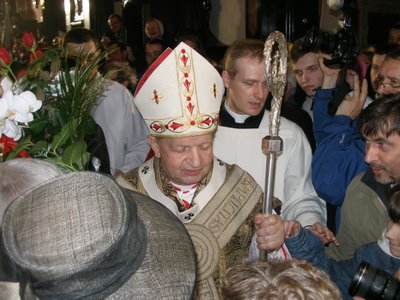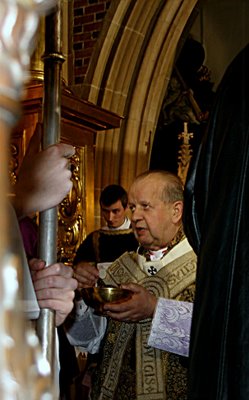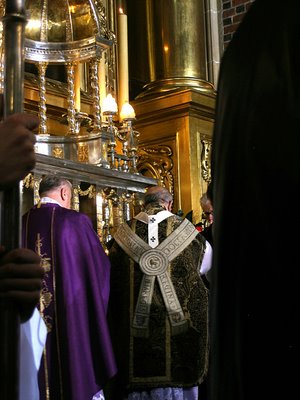
Cardinal Dziwisz Processes Out after the Solemn Ingress Mass


Cardinal Dziwisz gives the Body of Christ to the concelebrating Bishops.
Christus Vincit, Christus Regnat, Christus Imperat!
With these words, Stanislaw Cardinal Dziwisz made his solemn entrance (ingress) into the Royal Cathedral on Wawel Hill, the one thousand-year-old seat of the bishops of Krakow. As a result of a very interesting and unexpected meeting with a priest, I was able to attend the ceremony, which was open only for those with invitations. The Solemn Mass was attended by the “cream of the crop,” “who’s who in Krakow and Poland,” with many government dignitaries (again, Prime Minister Marcinkiewicz), as well as Church bishops, cardinals, and other members of the hierarchy. Somehow, I was able to find a spot very near to the main nave, near the front, by the high altar. Finding this spot, I had to make sure that I would not move, since the hundreds of photographers, and cameramen from newspapers from around the world, were acting in their typical journalist manner, trying to shove through to get the best possible spot to take a picture!
After the official ingress of Cardinal Dziwisz into the cathedral, he processed around the outer naves, and then into the sacristy, where he, Cardinal Macharski, Cardinal Nagy, and other cardinals and bishops prepared to celebrate the Mass for the Beatification of the Servant of God John Paul II. Since I was near the sacristy, which is located in the front of the basilica, near the high altar, I was able to be in the front row as the procession came by. I was overcome with emotion, and the only way I can explain it is to compare it to the emotion that I felt when I was able to be about five feet away from John Paul II at World Youth Day in Toronto. I was filled with so many thoughts, feelings, and emotions, and only after the procession came by, was I able to notice that I had stopped breathing and my heart was pounding. Here, about a foot away from me, passed Cardinal Dziwisz, the humble priest from the village of Rabka Wyżna, faithful servant of the Holy Father, and now elevated to the ranks of a Prince of the Church. And here he was in front of me, in all of his humble majesty. Donning the traditional “Vestment of St. Jadwiga,” the traditional vestment of the Archbishops of Krakow, which was placed over the Metropolitan’s Pallium, as well as an eighteenth century Roman chasuble, the cardinal passed by me.
Yet, I was struck by his humility, which I am sure that his short stature emphasized. I was surprised that, unlike Cardinal Macharski, whom I was able to greet and who is over six feet tall, Cardinal Dziwisz is a very short man—only about 5’8”, or a little bit more, but definitely not taller than me. (Of course, the medieval miter he was wearing made him look taller). Though he was next to me for about two seconds as the procession came by, the moment seemed like eternity. My mind was filled with thoughts of the late Holy Father, of the fact that this holy man who was in front of me, served a modern saint for over forty years! The aura of the sanctity of John Paul radiated from his personal secretary, who passed by in front of me, and reminded the congregation of Church officials and government dignitaries that “Pope Benedict has given a great gift to the Church of Krakow, a cardinal who is in great need of prayers and recommends himself to all of the faithful of the local church, asking for prayers.” Just as Pope Benedict XVI was called by the Holy Spirit to continue the radical call to holiness left behind by his predecessor, so Cardinal Dziwisz has been called to follow in the footsteps of his predecessor, Cardinal Karol Wojtyla, to shepherd the Church of Krakow and never cease to preach the Gospel of Modernity.
The Mass continued with a few opening statements from Cardinal Dziwisz, who was the homilist for the Mass. The Gospel for yesterday’s Liturgy could not have been better for the occasion. “Some in the crowd who heard these words of Jesus said, ‘This is truly the Prophet.’ Others said, ‘This is the Christ.’ But others said, ‘The Christ will not come from Galilee, will he?’” (Jn 7:40-41). Just as people could not believe that the Messiah would come from Galilee, so also people could not believe on October 16th, 1978, that the Successor of Peter, the Vicar of Christ, would come from Kraków, Poland. And yet, he came and he reached out to the entire world, drawing from his experiences of suffering, of persecution, from his Polish experience, and sharing the liberating message of Jesus Christ, of the Word Who was made flesh, in order to truly reveal man to himself. In Poland, Wojtyla was forced to deepen his understanding of man, to struggle to understand the condition of man’s fallen nature, and the depth of the liberating redemption that only Christ can offer. In Poland, he realized the true meaning of a life in the Spirit, where he saw God the Father changing the lives of young men and women during an era of repression and intolerance of religion. In the darkness, he saw the light. And then, this same Holy Spirit with Whom Karol Wojtyla was filled, chose him to share the truly liberating message of the Gospel with the entire world, to go to the very far corners of the earth and to “teach all the nations.” Cardinal Dziwisz then reflected on his humble call to service to live alongside this great saint.
Though it was hard for me to see at times, since I was pushed out of the way by a French photographer (who decided to wear jeans to the occasion, and kept asking who was who among the bishops and cardinals), I was simply caught up in the greatness and historicity of this moment. Here I was, participating in the official ingress, or “installment” as Cardinal in Krakow of a man who has been forever entered into the pages of the book of history, as he “whom served John Paul the Great,” faithful unto his death. As archbishop, he is determined to make the legacy of the Holy Father continue in Poland and in the world, and has requested for the construction of the “Be Not Afraid John Paul II Center” in Krakow. The center will combine all of the elements of John Paul II’s teaching; a hospital will serve the sick and suffering, schools will form young men and women in the light of the Gospel, a museum will ensure that the Holy Father’s cultural legacy lives on, and classrooms and auditoriums will provide a place to carry on dialogue on important social and ecumenical issues in the modern Church and society.
At the end of the Mass, which was celebrated at the High Altar of St. Stanislaw, Bishop and Martyr, the cardinal and all of the bishops processed out. Once again, the procession encountered a “traffic jam,” forcing Cardinal Dziwisz to stop right in front of me! I felt like the moment lasted forever, again, and I wanted to reach out, to touch him, to grasp the hand which cared for John Paul II, the hand which John Paul II blessed in his dying moments. Yet, I felt that all I could do was to simply bask in the presence of the glory of God and the power of the Holy Spirit. I felt like I was the only one there, with the Cardinal, who emanated such grace and humility (even though I was practically trampled by a four-foot-tall older Polish lady, who wanted to give the cardinal a bouquet of roses!)
A few minutes after the recession, the second solemn event of the evening began, with the procession of the bishops, priests, and cardinals involved in the beatification process in Krakow. Yesterday marked the 29th and last plenary session of the Rogatory Tribunal in the beatification process, which was instituted in order to help the Diocese of Rome to gather information, testimonies, and the necessary legal requirements for a speedy beatification process. The delegate judge, Bishop Tadeusz Pieronek, officially closed this first process with the announcement that an 800-page book of proceedings was complete, and now the beatification process could continue much more easily and swiftly. The official documents were signed by Cardinal Dziwisz, and then sealed in a special white container, in the presence of the notary, Fr. Andrzej Wojcik. After the documents were placed in it, the container was sealed with candle wax, stamped, and sent to the Archdiocesan archives, not to be opened in the future without specific permission of the Holy See. With the following words, the process was sent to Rome for the final stages before the Beatification can take place:
Et ego Notarius deputatus fidem facio ac testor supra relatas subscriptions, nempe illam Em.im Archiepiscopi, Iudicis, Iudicis Adiuncti, Promotoris Iustitae, Notarium Adiunctorum et Postulatoris, fuisse et esse an ipsis propiis minibus factas et sriptas in mea praesentia; atque ita testor et fidem facio hac die prima, mensis Aprilis, anno 2006.
ITA EST.
And so our beloved Holy Father is one step closer to being “officially recognize as a saint,” since “we already all know that he is in the Father’s house, looking down on us,” reminded Cardinal Dziwisz. After the official closing of the process, spontaneous applause broke out within the cathedral, acknowledging and thanking both the many, many people involved in the beatification process, but more importantly, in an act of gratitude for the great gift of John Paul to the Church.
In usual Polish fashion, the entire evening was filled with a mix of Polish patriotism and Roman Catholicism, as was evident in the closing hymn, “Boze Cos Polske,” which speaks of Divine Providence watching over Poland:
Oh Lord,
Who hast filled Poland with the splendor of Your power and glory throughout the centuries,
Who hast shielded her with the shield of Your might,
From the tragedies which were to dishearten her,
We bring before Your altars our cry:
Bless our nation with freedom, Lord.
The hymn was a solemn reminder to everybody of the necessity of living in true freedom. As John Paul II reminded in 1991, on the threshold of a new post-communist Poland, “Poland has found herself once again at an important moment, a unique moment, and perhaps even a decisive moment, which cannot be wasted for any reason whatsoever…This is a great gift from God, a kairos of our history, which has both been given, but also entrusted…I pray for you and with you for this ‘examination in freedom’ which lies before you…Dear brothers and sisters, I am one of you…I always was, and still am. I love my nation, and I was never indifferent towards its sufferings, its limitations of freedom, its plight. Now, I am not indifferent towards this new ‘trial of freedom,’ before which we all stand…I repeat to everyone: Be grateful to God, and never put out the flame of the Holy Spirit!”



3 comments:
Your description of how you felt having Cardinal Dziwisz standing so close to you sounds exactly how I felt when I met him. Our meeting was nothing more than a split second hello and nod, but I longed to touch him.
Perhaps someday I will be able to greet him properly. I have a letter that he wrote to me. I treasure that letter because he signed it. Cardinal Dziwisz is the closest we can get to Pope John Paul. Therefore we love him. He is a beautiful, gentle, humble person and I love him for that also.
I just finished watching this Mass through the miracle of the internet. How very lucky for you to have been there. Card. Dziwisz seems to be growing in holyness every time I see him. I loved the chansable he was wearing. Don't see many like that here in California. Keep up the blog.
Andrew A.
wish i were there!!
Post a Comment